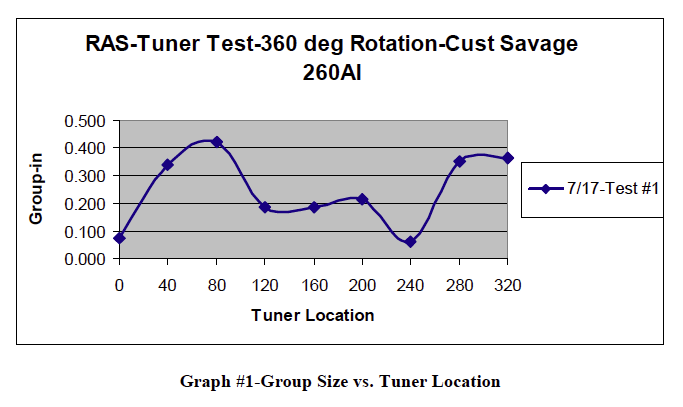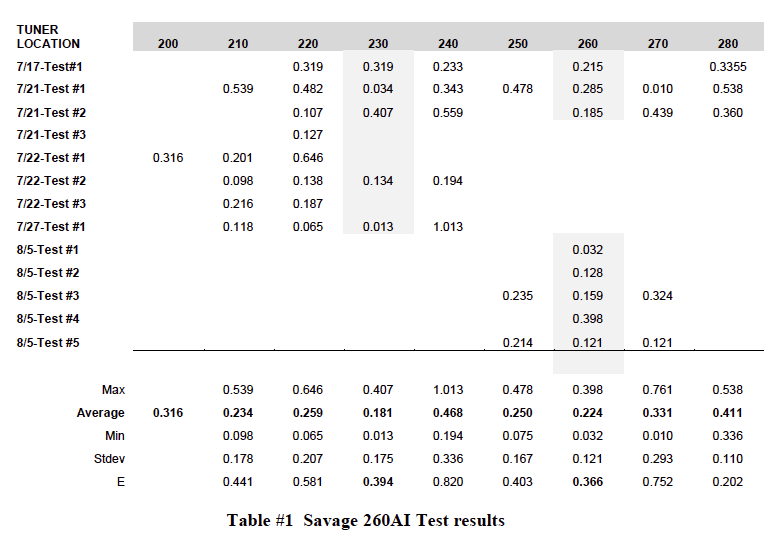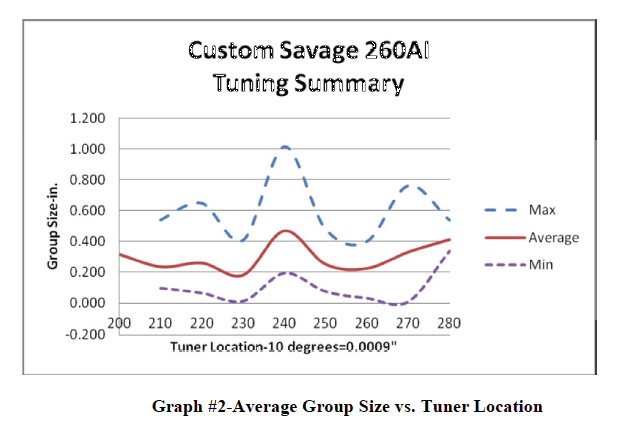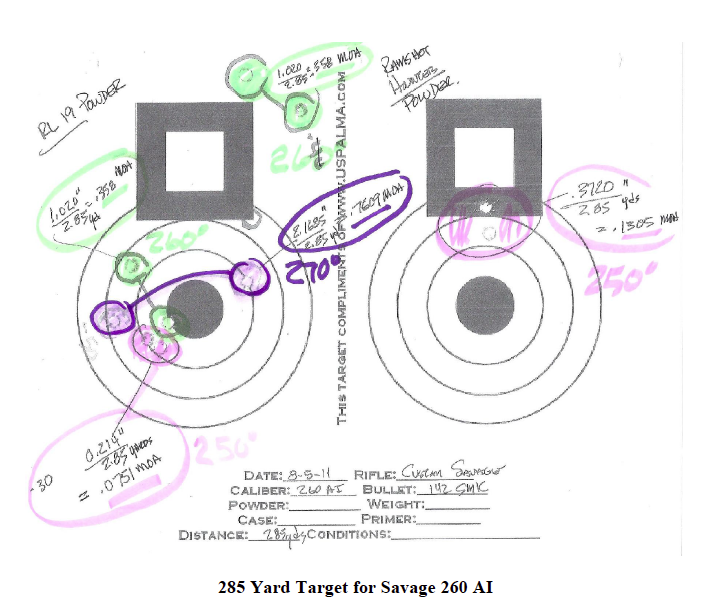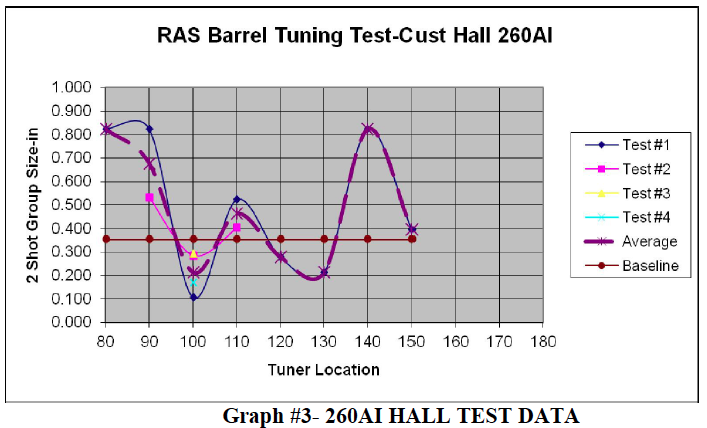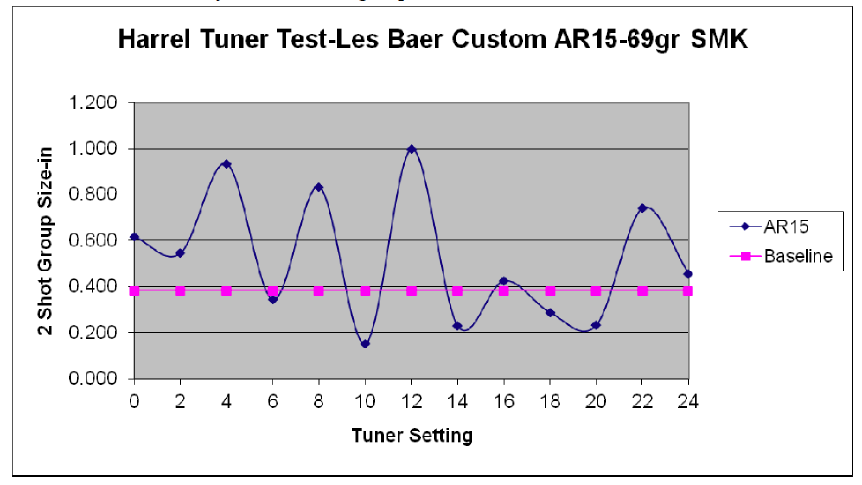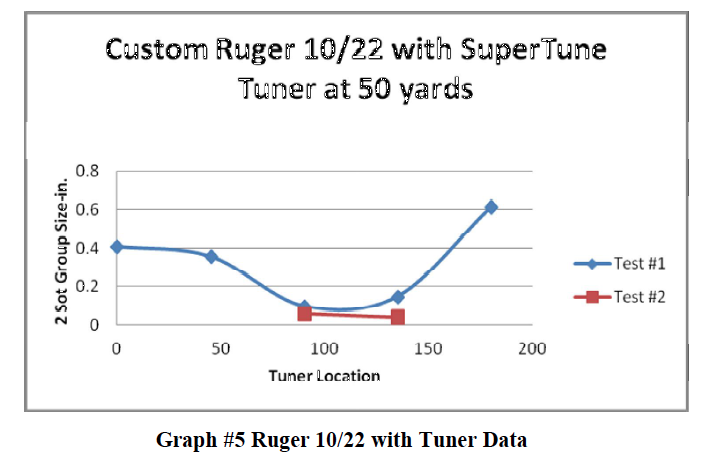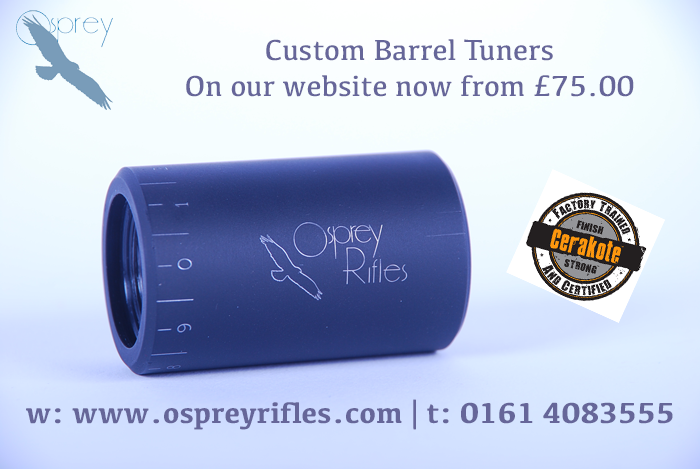BARREL TUNERS FOR CENTREFIRE RIFLES
Most of us will be aware of the use of barrel tuners on rimfire competition rifles, where the shooter cannot ‘tune’ his ammunition and therefore must tune the barrel to obtain maximum accuracy. As a spin-off from rimfire benchrest – where the tuner is ‘de rigueur’ – a few centrefire BR shooters are also dabbling with tuners.
However, I was amazed to see that some F Class shooters were also using tuners at the recent World Championships in Raton and I picked up on a forum posting by Team USA member Eric Cortina and started to get a bit more interested. I was trolling the internet to find out as much as I could on tuners when the following article arrived…………..perfect! – Ed.
Improved Rifle Accuracy by Jim & Jerry Bennington
Tuners work on rim fire rifles. Do they work on center fire rifles and if so are they repeatable and how much improvement do they provide?
Accuracy is about managing the barrel vibrations. Of course, this assumes that there is an accurate scope and it is properly mounted. It also assumes that the shooter mounts the rifle properly on the bench and does his job of reading the conditions and firing the rifle. The greater the accuracy demanded, the more the skill required of the shooter.
As you read the reviews in the gun magazines, the authors typically try several factory loads and shoot five-shot groups. They then list the best, worst and average group-sizes for each load. They do this because EVERY individual rifle has an inherent dynamic response, primarily barrel vibrations, to the forces generated by given load. Since the resulting groups are a function of the shooter, environment (wind, mirage…) and the rifle dynamics, there is an unavoidable randomness to the group sizes. The challenge to load development in reloading is finding the loading combination of primer, powder, load, neck tension, seating depth and so forth, that has the best average group size AND smallest variation. Most of us have a cut-out of a target with a great group in our billfold. But, one great group isn’t enough; you need to ensure that the performance is consistently repeated to have an accurate load.
In a similar manner, changing the rifle to improve its dynamics can improve the accuracy. Free floating a barrel is one example that is widely used. Barrel tuners are another tool that have the potential to make a good rifle even better. We will share our experience with developing and testing tuners. They show that tuners on several centerfire rifles can consistently and with repeatability improve accuracy.
This project started with Larry Tolksdorf, Eric Bostrom and Jim Bennington shooting at the Manatee Gun & Archery Club (MGAC) in Myakka City, Florida. The Manatee Club has a 1000 yard range and holds monthly gong matches at both 1000 yards and 560 yards. Gunsmith Eric Bostrom has been building very accurate custom Savage long-range rifles that have been dominating these long-range matches. The authors have been interested in rifle tuning since before Browning introduced their BOSS system in 1995. These interests resulted in the development and patent applications for the Rifle Accuracy System, which is our combination tuner and muzzle brake. After discussing the design needs for sometime, Larry T & Eric Bostrom built the first prototype. The pictures below show the final product.

Initial applications of the Rifle Accuracy System showed significant improvements in accuracy but were not conducted in a structured fashion to allow consistent evaluation. This test program described here is intended to provide the initial data to better understand the tuning system and its relationship to accuracy.
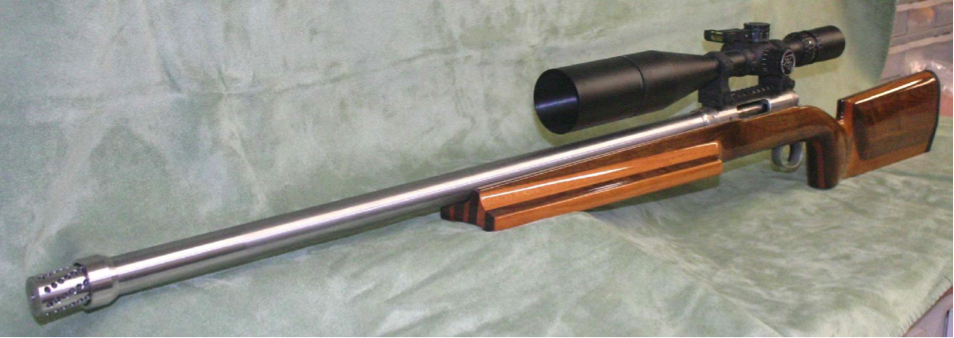
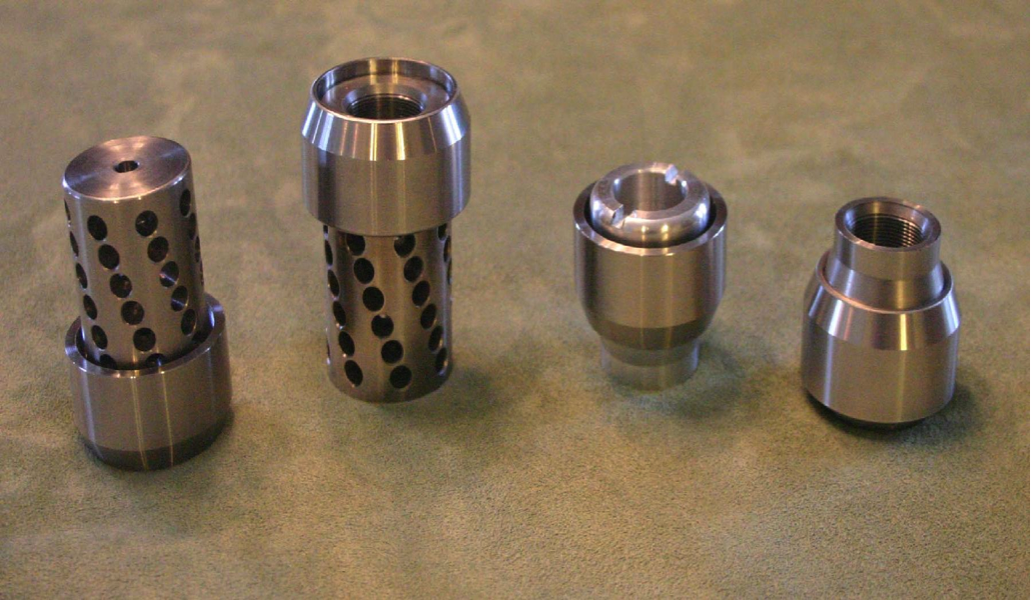
History – Muzzle brakes
Muzzle brakes were probably first used on military canons and can currently be seen on a wide variety of them. Magna-Port was one of the first to adapt muzzle brakes to handguns and rifles. There are currently muzzle brakes in a wide variety of designs available. Whilst a muzzle brake can significantly reduce recoil, it also significantly increases the noise to the shooter and those near him. There is no free lunch; recoil energy is exchanged for pressure (noise) energy. Muzzle brakes play an important role in long-rang shooting. They aid the shooter in seeing the impacts of his shots though this is not true at longer ranges like 1000 yards.
Tuners
Tuners are a more recent innovation. Browning introduced one of the early commercial tuner systems with their BOSS system in 1995. Most competitive 22 RF shooters use tuners to match their ammunition to their rifles. It is widely understood that one cannot be competitive in 22 RF matches without a tuner. Short-range benchrest shooters have recently used tuners to improve their accuracy. Now, with the popularity of long-range competition and varmint shooting, tuners are increasingly being used.
Theory
There are two independent types of barrel vibrations.
1. The pressure inside the barrel causing it to expand and contract in a harmonically defined fashion (much like the string on a violin vibrates when it is plucked) as it moves along the barrel causes the first type of vibration. When the bullet leaves the muzzle when it is at its smallest diameter, accuracy is improved. When the muzzle has expanded and is larger than the minimum, it acts like a bad crown with the bullet smaller than the bore. Formulas to calculate Optimum Barrel Time are provided in the appendix. This vibration mode depends on only barrel length. With the use of the Quick Load and Pressure Trace products barrel times can be estimated.
2. The second and most significant type of vibration is the bending mode of the barrel. Think of clamping a steel ruler to a bench and then bending and releasing the free end. The ruler will vibrate based on its characteristics and the force applied to start the vibrations. A gun barrel functions in the same but much more complicated way.
In the case of our ruler one can write a differential equation of motion to describe the motion, velocity and acceleration of any point on the ruler. To do this for the rifle barrel is far more complicated.
Let’s consider the series of events from the time the trigger is pulled until the bullet leaves the muzzle. Each of the following events happens at a small, millisecond time lag after the previous event.
- The trigger is pulled to release the sear
- The sear releases the firing pin
- The firing pin moves forward, striking the primer
- The primer and cartridge are driven forward
- The primer ignites causing it to move rearwards, striking the bolt face
- The powder begins to burn and causes the bullet to move forward
- The bullet strikes the rifling and begins to spin
- The action and barrel moves rearward in recoil until the recoil lug is stopped by the stock
- The entire rifle recoils
The list could go on but, the reader should get the point. Each of the events can be described with a differential equation of motion, each spaced slightly different in time. All of the differential equations need to be simultaneously solved to get a picture of the barrel vibration. Solving the equations is not important, but knowing they exist is. What the shooter sees is the sum of all these. You might ask why this is important. We will try to answer that question shortly.
The barrel will vibrate with a number of modes or harmonics. Simply put, each successive mode (harmonic) will cross the centerline (the nodal point) of the barrel one more time than the previous mode (harmonic) and be at a higher frequency. For example, if the second mode (harmonic) were 445 cps, the third mode might be 1,246 cps. As the harmonics increase, the final crossing point gets closer to the muzzle. A good example of this can be found on Varmint Al’s web site www.varmintal.com. His barrel tuner analysis will demonstrate this effect.
Jim Boatwright wrote an excellent article in Precision Shooting a few years ago describing how this barrel vibration causes aiming errors. The closer the nodal point is to the muzzle when the bullet exits, the less the error. The problem is that the nodal point is a function of the barrel length. Shortening or lengthening the barrel still leaves the nodal point some distance before the muzzle. When we add a muzzle brake the barrel thinks it is longer, and the nodal point moves closer to the muzzle. That is why most rifles shoot better with a muzzle brake or suppressor. If the muzzle brake is too long, the nodal point can move forward of the muzzle and accuracy will decrease.
As described earlier, the Rifle Accuracy System adds a movable weight to the muzzle brake. Slight 5-degree (.00045″) changes of the location of the tuning weight can make significant changes on group size. Why is that? Think about all the various influences on the vibrations listed above. The slight movements of the tuner weight location can change all of them, either increasing or diminishing the magnitude of the muzzle motion. The concept is much like noise canceling headphones, which create a vibration just the opposite as the one to be eliminated. It is much easier to test this than it is to calculate it.
Test goal
The testing has three goals:
- Show that tuner settings change the average group size
- Show that tuner results are consistent across shooting sessions
- Illustrate a procedure for determine a ‘near optimal’ tuner setting
- Illustrate the effects of the uncontrollable variations within the two-shot groups used in the tuning procedure
If one were trying to measure improvements in a rifle shooting 11/2 inch groups and the tuner reduced the group to ¾ inches, that would seem to be a big improvement. In this case the skill of the shooter has a lesser impact on the results. In the case of accurate rifles that shoot under 1⁄2 inch, the skill of the shooter becomes a much bigger factor in evaluating changes.
In the real world, if the shooter’s skill was the only variable, there would be some minimum group size that the shooter could consistently maintain. Consider the very best of the benchrest competitors their averages can be in the low ‘twos’ (0.200in.) or high ‘ones’ (0.100in.). Typically, in competition, five sets of five-shot groups are averaged to determine accuracy.
The goal for this test was to provide data as to the degree of accuracy improvements to be expected with the Rifle Accuracy System and the repeatability of these measurements. The sensitivity to tuner adjustment as it related to accuracy was explored. The use of the tuner system and other tuners were used to examine a range of applications
The barrel will wear a little with every shot changing the test results with time. It was decided to try to minimize that problem with this test. Tests were conduct with two (2) shot groups. “If two shots don’t group, three shots will not improve it.” Unfortunately, a great two-shot group DOESN’T mean that the resulting three or five shot group will be small. Hence, multiple groups must be shot to determine the average group size and variation for a given tuner setting. By shooting multiple two-shot groups at each tuner location and averaging the results, we could determine the relationship between tuner location and accuracy. To further verify this additional three (or more) shot groups could then be fired
Test conditions
The tests reported in this article were conducted on a private range in northeast Michigan. The range lies north to south and is surrounded by pine trees. During the duration of this test the conditions were calm winds and temperatures from the mid seventies to high eighties. Velocities were measured with a CED chronograph located 20 feet from the muzzle. Test were conducted at 100 yards and verified at 285 yards (maximum for the range). It should be noted that all the rifles used in these test were very accurate custom rifles.
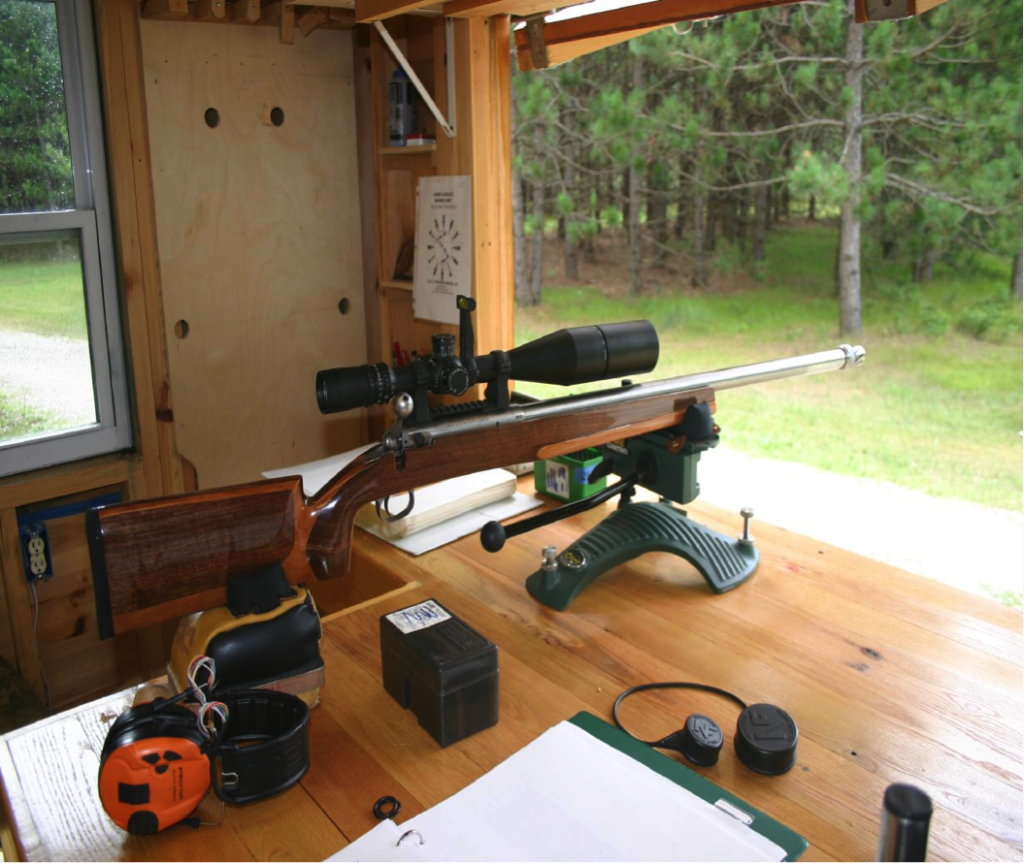
Test rifles & loads – Savage 260AI – Eric Bostrom Gunsmith
Savage 12 LRPV left port, right bolt action, Kreiger SS 6.5mm, 30 inch, 7:1 twist barrel, Rifle Basix trigger, Nightforce 8×32 NXS Scope, custom stock by Eric Bostrom and a Rifle Accuracy System by Precision Rifle Systems, LLC
Loads: Remington brass, 210M primers, Ramshot Hunter powder and moly-coated Sierra 142 MK bullets set 0.015 inches off the lands. Velocity about 2900 fps
Test results – Savage 260AI
Group-in
The Rifle Accuracy Systems was initially set two turns, 720 degrees, back from its maximum forward position.
Initial groups were shot using 40-degree rotation (0.0035in.) between groups for one full 360-degree rotation.
The group sizes ranged from the largest (0.421in.) at 80 degrees to the smallest (0.073in.) at 0 degrees and (0.062in.) at 240 degrees.
Experience has shown that with each revolution of the tuner similar results will occur.
Graph no.1 above gives us a starting location to meet our test goals.
The next step was to fire a series of groups from 200 to 280 degrees in 10-degree (.0009″) increments. There were 13 tests, 42 groups or 84 shots fired to define the tuners performance with the Savage rifle. The result of all these groups is shown in Table #1 below. As can be seen, it is hard to get a specific answer to our goals from the data as shown. It can be seen that the all the groups tried to show a harmonic oscillation shape.
Tuner location
To better define the data, the average, maximum and minimum group sizes were determined for each tuner setting. Graph no.2 shows the average results and the range of the data. Graph no.2 also shows that the smallest average groups were achieved at tuner settings at 230 degrees. The minimum variation in groups was also achieved at the 230 setting.
Now to address our test goals:
1. Show that tuner settings change the average group size.
The data clearly shows that group sizes change with tuner settings.
2. Show that tuner results are consistent across shooting sessions.
By averaging the test data it can be seen that there is consistency at the tuner settings within the bounds of the range of results.
3. Illustrate a procedure for determining a ‘near optimal’ tuner setting.
As described at the beginning of this article, a 360 degree rough test will provide a starting point for the best setting. Then, tests in smaller increments about the small group as a starting point will provide near-optimal accuracy. Additional tests may improve results. Shooting multiple two-shot groups is essential because we are trying to find a tuning point that is partially obscured by the variation in group sizes due to other factors – principally wind, mirage and shooter error. The more two-shot groups fired at a given tuner setting, the greater the statistical confidence in the results.
4. Illustrate the effects of the uncontrollable variations within the two shot groups used in the tuning procedure.
The maximum, minimum data shown in Table 1 and Graph 2 give an indication of the variations and how they relate to tuner settings.
285 Yards
Since one of the goals of this project was to improve long-range accuracy, groups were tested at the maximum distance of the range – 285 yards. The following target shows that the tuner setting needed to be adjusted by 10 degrees – from 260 degrees to 250 degrees – for best accuracy. What is interesting is the groups shot with two different powders at the same best tuner setting – 250 degrees. The Reloader 19 group was 0.0751 MOA and the Hunter group was 0.1305 MOA. Since all the 100 yard data was with the Hunter powder – because it was faster – one might wonder how much better the 100 yards groups might have been if the Reloader 19 powder had been used.
The next question – how does Rifle Accuracy System tuning change with a different rifle? A very accurate benchrest rifle was chosen. This rifle was originally a 6PPC Bench Rest rifle made by Dwight Scott. The rifle has a Hall action. The barrel was changed for this test to a Broughton 6.5 mm, 28 inch, 8:1 twist barrel, chambered for a 260 AI with the same reamer used on the Savage barrel. The rifle has a Jewel trigger, T36 Weaver Scope and the Rifle Accuracy System. The Hall’s only common feature with the Savage is the 260 AI cartridges. The Hall action has been glued into the Adamowicz stock. The load was MRP powder, 139gr. Moly-coated Lapua bullets, Federal 210M primers, Remington brass. What was surprising is that the best tuner locations were within 0.0009in. of the best locations on the Savage.
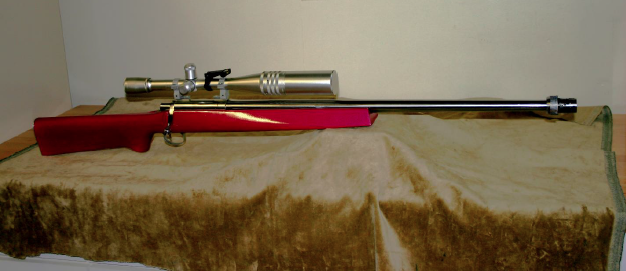
What happens to a rifle that doesn’t need a muzzle brake and just uses a tuner?
To answer this question a tuner was adapted to a very accurate Les Baer AR 15, 223 Lake City Brass, Federal 205M primers, Ramshot TAC powder, Sierra 69gr moly coated Match King bullets.
COAL = 2.248in. Les Baer 24in., 9:1 twist, SS barrel with modified Harrell Tuner.
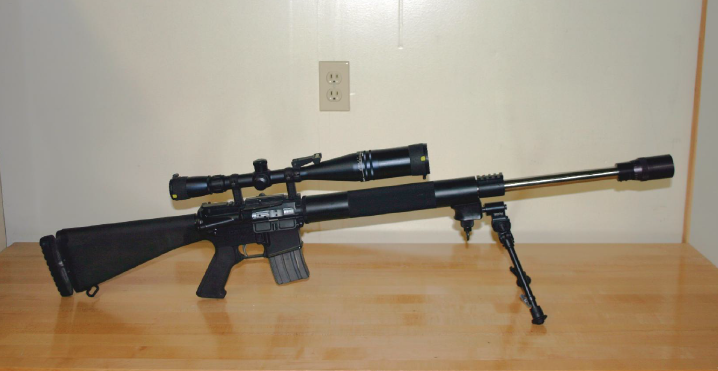
Without the tuner, this load typically shoots 5-shot groups under 0.400in. The addition of the tuner substantially reduced these groups.
The 22 RF benchrest shooters have long used tuners to match their rifles to their ammunition. What happens if we put a tuner on a Ruger 10/22? A SuperTune tuner was modified to adapt it to the barrel of the 10/22 custom Ruger 10/22. Wolf 22 LR Ammunition.
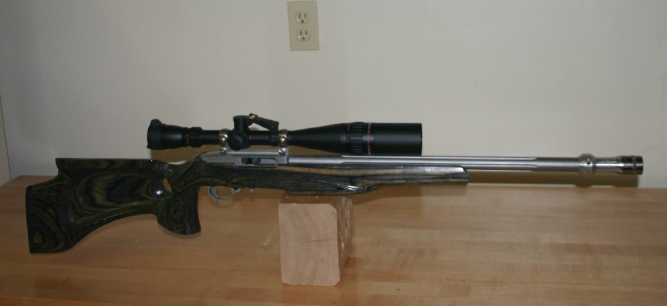
Conclusions
Tuners work on centerfire rifles and are the results are repeatable. Tuners and the RAS specifically, will make substantial improvements in rifle accuracy.
The tuning requires little effort to improve accuracy. Maximizing the accuracy takes some additional effort. Tuner locations may require slight changes to maintain their advantage as conditions, distance and loads change.
Next step
Shoot 5 & 10 shot groups at longer range, 565 and 1000 yards, whilst changing tuner locations.
Determine sensitivity to tuner location at 200 yards. Testing was done with 10 degree (0.0009in.) increments in tuner location. Will smaller increments improve accuracy?
Appendix
Eric Bostrom-Myakka City, FL, 941-322-2487 Precision Rifle Systems, LLC, – Myakka City, FL, 941-322-2487
Harrell’s Precision-Salem, VA, 541-380-2683, www.harrellsprec.com SUPERTUNE-Time Precision, Bethel, CT, 203-744-1052. QuickLoad-NECCO, 800-451-3550 www.neconos.com PressureTrace-RSI, Recreational Software, Inc, 928-634-8028 www.shootingsoftware.com
Chris Long has explained the concept of Optimum Barrel Time on his web site www.the-long-family.com/obt in great detail. Rifle Accuracy Facts by Harold Vaughn – published by Precision Shooting Harold Vaughn in his book Rifle Accuracy Facts explains some of the sources of the vibrations.
Varmint Al www.varmintal.com Varmint Hunter Magazine April-June 2009, pages 170-174


